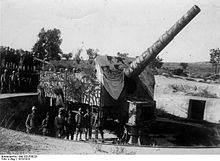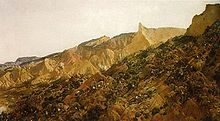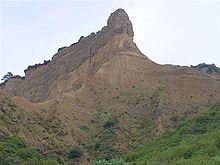- Gallipoli Campaign
-
See also: Timeline of the Battle of Gallipoli
Gallipoli Campaign Part of the Middle Eastern Theatre (First World War) 
Gallipoli Campaign, April 1915.Date 25 April 1915 – 9 January 1916 Location Gallipoli peninsula, Ottoman Empire Result Decisive Ottoman victory Belligerents  British Empire
British Empire
 Ottoman Empire
Ottoman Empire
 Germany[2]
Germany[2]
 Austria-Hungary[3]
Austria-Hungary[3]Commanders and leaders  Sir Ian Hamilton
Sir Ian Hamilton
 Lord Kitchener
Lord Kitchener
 John de Robeck
John de Robeck Esat Pasha
Esat Pasha
 Otto Liman von Sanders
Otto Liman von Sanders
 Vehip Pasha
Vehip Pasha
 Cevat Pasha
Cevat Pasha
 Lieutenant Colonel Mustafa Kemal
Lieutenant Colonel Mustafa KemalStrength  British Empire:
British Empire:
489,000[4]
 France:
France:
79,000[4]
5 divisions (initial)
16 divisions (final) Ottoman Empire:
Ottoman Empire:
315,500[4]
6 divisions (initial)
15 divisions (final)Casualties and losses 220,000, 59% casualty rate[5] 251,000, 60% casualty rate[6] Gallipoli CampaignTheatres of World War I- Caucasus
- Persia
- Gallipoli
- Mesopotamia
- Sinai and Palestine
- South Arabia
- South-West Africa
- West Africa
- East Africa
- North Africa
Other theatres:
- America
- Atlantic Ocean
- Mediterranean
The Gallipoli Campaign, also known as the Dardanelles Campaign or the Battle of Gallipoli,[7][8][9][10][11] took place at the peninsula of Gallipoli in the Ottoman Empire (in modern day Turkey) between 25 April 1915 and 9 January 1916, during the First World War. A joint British and French operation was mounted to capture the Ottoman capital of Constantinople and secure a sea route to Russia.[12] The attempt failed, with heavy casualties on both sides. The campaign was considered one of the greatest victories of the Turks and was reflected on as a major failure by the Allies.
The Gallipoli campaign resonated profoundly among all nations involved. In Turkey, the battle is perceived as a defining moment in the history of the Turkish people—a final surge in the defence of the motherland as the aging Ottoman Empire was crumbling. The struggle laid the grounds for the Turkish War of Independence and the foundation of the Republic of Turkey eight years later under Mustafa Kemal (Atatürk), himself a commander at Gallipoli.
The campaign was the first major battle undertaken by the Australian and New Zealand Army Corps (ANZAC), and is often considered to mark the birth of national consciousness in both of these countries. Anzac Day, 25 April, remains the most significant commemoration of military casualties and veterans in Australia and New Zealand, surpassing Armistice Day/Remembrance Day.
Contents
Decision to attack
The Allies were keen to open an effective supply route to Russia: efforts on the Eastern Front relieved pressure on the Western Front. Germany and Austria-Hungary blocked Russia's land trade routes to Europe, while no easy sea route existed. The White Sea in the north and the Sea of Okhotsk in the Far East were distant from the Eastern Front and often icebound. The Baltic Sea was blocked by the German Kaiserliche Marine. The Black Sea's only entrance was through the Bosporus, which was controlled by the Ottoman Empire. When the Ottoman Empire joined the Central Powers in October 1914, Russia could no longer be supplied from the Mediterranean Sea.
By late 1914 the Western Front in France and Belgium had effectively become a stalemate. A new front was desperately needed. Also, the Allies hoped that an attack on the Ottomans would draw Bulgaria and Greece into the war on the Allied side. A first proposal to attack the Ottoman Empire had been made by the French Minister of Justice Aristide Briand in November 1914, but it was not supported. The British attempt to bribe the Ottoman Empire to join the Allied side was also not successful; their offer of £4 million was trumped by Germany's £5 million.[13]
Later in November 1914, First Lord of the Admiralty Winston Churchill put forward his first plans for a naval attack on the Dardanelles, based at least in part on what turned out to be erroneous reports regarding Ottoman troop strength. He reasoned that the Royal Navy had a large number of obsolete battleships which could not be used against the German High Seas Fleet in the North Sea, but which might well be made useful in another theater. Initially, the attack was to be made by the Royal Navy alone, with only token forces from the army being required for routine occupation tasks.
First Sea Lord John Fisher opposed the campaign and instead preferred a direct naval landing on the north coast of Germany, but Churchill won the argument.[14]
Main article: Naval operations in the Dardanelles Campaign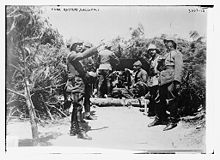 Mehmed Esad Pasha (Bülkat) and Ottoman battery at Gallipoli
Mehmed Esad Pasha (Bülkat) and Ottoman battery at Gallipoli
Attempt to force the Straits
On 19 February, the first attack on the Dardanelles began when a strong Anglo-French task force, including the British battleship HMS Queen Elizabeth, bombarded Ottoman artillery along the coast. Many believed victory to be inevitable. Admiral Carden sent a cable to Churchill on 4 March, stating that the fleet could expect to arrive in Istanbul within 14 days.[15] A sense of impending victory was heightened by the interception of a German wireless message which revealed the Ottoman Dardanelle forts were close to running out of ammunition.[15] When the message was relayed to Carden, it was agreed a main attack would be launched on or around 17 March. It transpired that Carden, suffering from stress, was placed on the sick list by the medical officer, meaning the fleet was now placed in command of Admiral de Robeck.
On 18 March the main attack was launched. The fleet, comprising 18 battleships with a supporting array of cruisers and destroyers, sought to target the narrowest point of the Dardanelles, where the straits are just a mile wide. Despite some damage sustained by ships engaging the Ottoman forts, minesweepers were ordered to proceed along the straits. According to an account by the Ottoman General Staff, by 2pm "All telephone wires were cut, all communications with the forts were interrupted, some of the guns had been knocked out... in consequence the artillery fire of the defense had slackened considerably".[16] The French battleship Bouvet was sunk by a mine, causing it to capsize with its entire crew aboard. Minesweepers, manned by civilians and under constant fire of Ottoman shells, retreated leaving the minefields largely intact. HMS Irresistible and HMS Inflexible both sustained critical damage from mines, although there was confusion during the battle about the cause of the damage—some blamed torpedoes. HMS Ocean, sent to rescue the Irresistible, was itself struck by an explosion and both ships eventually sank.[17] The French battleships Suffren and Gaulois were also damaged. All the ships had sailed through a new line of mines placed secretly by the Ottoman minelayer Nusret 10 days before.
The losses prompted the Allies to cease any further attempts to force the straits by naval power alone. Losses had been anticipated during the planning of the campaign, so mainly obsolete battleships had been sent which were unfit to face the German fleet. However, many naval officers—including de Robeck and Fisher—did not consider the losses acceptable. The defeat of the British fleet had also given the Ottomans a morale boost, although their gunners had almost run out of ammunition before the British fleet retreated. The reasons for the decision to turn back are unclear.
Preparations for a landing
After the failure of the naval attacks, it was decided that ground forces were necessary to eliminate the Ottoman mobile artillery. This would allow minesweepers to clear the waters for the larger vessels. The British Secretary of State for War, Lord Kitchener, appointed General Sir Ian Hamilton to command the Mediterranean Expeditionary Force that was to carry out the mission.
At this time, early 1915, Australian and New Zealand volunteer soldiers were encamped in Egypt, undergoing training prior to being sent to France. The infantry were formed into the Australian and New Zealand Army Corps (ANZAC), which comprised the Australian 1st Division and the New Zealand and Australian Division. General Hamilton also had the regular British 29th Division, the Royal Naval Division (RND) (Royal Marines and hastily drafted naval recruits) and the French Oriental Expeditionary Corps (including four Senegalese battalions) under his command.
Conditions at Gallipoli
Ottoman preparations
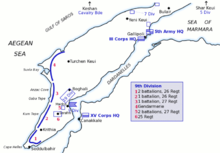 Disposition of the Ottoman Fifth Army
Disposition of the Ottoman Fifth Army
There was a delay of over six weeks before many of the troops arrived from Britain, allowing Ottoman forces time to prepare for a land assault. Ottoman commanders began to debate the best means of defending the peninsula. All agreed that the most effective form of defence was to hold the high ground on the ridges of the peninsula, but there was disagreement as to where the enemy would land, and hence where to concentrate their own forces. Mustafa Kemal, a 34 year old Lt.-Col., familiar with the Gallipoli peninsula from his operations against Bulgaria in the Balkan War,[18] believed Cape Helles (the southern tip of the peninsula) and Gaba Tepe would be the two most likely areas for landing. In the case of the former, Kemal perceived the British would use their navy to command the land from every side which the tip of the peninsula would allow. In Gaba Tepe, the short distance to the eastern coast meant forces could easily reach the Narrows.
Ultimately, Otto Liman von Sanders disagreed. In his view, the greatest danger posed was in Besika Bay on the Asiatic coast, where von Sanders believed British forces would benefit from more accessible terrain and target the most important Ottoman batteries guarding the straits.[19] As such, Sanders placed two divisions, a third of the total force of the fifth army, in this area.[19] Two more divisions were concentrated at Bulair at the northern isthmus of the peninsula: vital supply and communications lines would be cut, should the area be captured.[20] Finally, at Cape Helles, on the tip of the peninsula, and along the Aegean coast, the Ninth and Nineteenth Divisions were placed, the latter put under the command of Mustafa Kemal. For von Sanders, the bulk of the forces should be held inland with minor coastal defences spread across the peninsula. This strategy drew complaints from Ottoman commanders, including Mustafa Kemal, who believed Ottoman forces were too widely dispersed and thus not in a position to drive the attackers immediately into the sea as soon as their invasion commenced.[21]
The delay in landings by the British allowed Ottoman officers to prepare defenses. Von Sanders noted "The British allowed us four good weeks of respite for all this work before their great disembarkation... This respite just sufficed for the most indispensable measures to be taken."[22] Roads were constructed, small boats assembled to carry troops and equipment across the narrows, beaches were wired and makeshift mines constructed from torpedo-heads. Trenches and gun emplacements were dug along the beaches, while troops were regularly taken on long marches to avoid lethargy.[22] Mustafa Kemal, whose Nineteenth Division would become pivotal in the battle, observed the beaches and awaited signs of an invasion from his post at Boghali, near Maidos.
Unhealthy atmosphere
The conditions at Gallipoli, on both sides, were notorious. In the summer, the heat was atrocious, and in conjunction with bad sanitation, led to so many flies that eating became extremely difficult. Corpses, left in the open, became bloated and stank. The precarious Allied bases were poorly situated and caused supply and shelter problems. A dysentery epidemic spread through the Allied trenches in both Anzac and Helles. Autumn and winter brought relief from the heat, but also led to gales, flooding and frostbite.[23]
Land campaign
Landings
Main articles: Landing at Anzac Cove and Landing at Cape Helles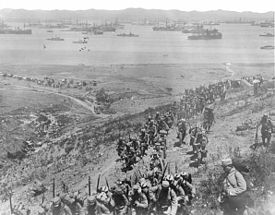 Landing of French troops on Lemnos island, 1915.
Landing of French troops on Lemnos island, 1915.
The invasion plan of 25 April 1915 was for the 29th Division to land at Helles on the tip of the peninsula and then advance upon the forts at Kilitbahir. The Anzacs were to land north of Gaba Tepe on the Aegean coast, from where they could advance across the peninsula, cutting off retreat from or reinforcement of Kilitbahir. The small cove in and around which they landed became known as Anzac Cove. This sector of the Gallipoli Peninsula became known as 'Anzac'; the area held by the British and French became known as the 'Helles sector' or simply 'Helles'. The French made a diversionary landing at Kum Kale on the Asian shore before re-embarking to hold the eastern area of the Helles sector. There was also a diversion by the Royal Naval Division, including a one-man diversion by Bernard Freyberg at Bulair, for which he was awarded the DSO. Later he became a Lieutenant-General during World War II, and went on to win the VC.
The Helles landing was made by the 29th Division under the command of Major-General Aylmer Hunter-Weston, on five beaches in an arc about the tip of the peninsula, designated from east to west as S, V, W, X and Y beach. The Jewish Legion also landed at Helles on the 25th, as well as a regiment of British Gurkhas, the 6th Gurkha Rifles; this unit took and secured Sari Bair above the landing beaches.[24]
The commander of the Y Beach landing was able to walk unopposed to within 550 yards (500 metres) of Krithia village, which was deserted. The British never got so close again. Y Beach was evacuated the following day as Ottoman reinforcements arrived.
The main landings were made at V Beach, beneath the old Seddülbahir fortress, and at W Beach, a short distance to the west on the other side of the Helles headland.
At Cape Helles V Beach the covering force from the Royal Munster Fusiliers and Royal Hampshires was landed from a converted collier, SS River Clyde, which was run aground beneath the fortress so that the troops could disembark directly via ramps to the shore. The Royal Dublin Fusiliers would land at V Beach from open boats. At W Beach the Lancashire Fusiliers also landed in open boats on a small beach overlooked by dunes and obstructed with barbed wire. On both beaches the Ottoman defenders were in a position to inflict appalling casualties on the landing infantry. The troops emerging one by one from the sally ports on the River Clyde presented perfect targets to the machine guns in the Seddülbahir fort. Out of the first 200 soldiers to disembark, only 21 men made it onto the beach.[25]
As at Anzac, the Ottoman defenders were too few to force the British off the beach; however, they furiously defended every inch of their soil. On the morning of 25 April 1915, out of ammunition and left with nothing but bayonets to meet the attackers on the slopes leading up from the beach to the heights of Chunuk Bair, the commander of the 19th Division, Lieutenant-Colonel Mustafa Kemal, issued his most famous order to the 57th Infantry Regiment:[26]
I do not order you to fight, I order you to die. In the time which passes until we die, other troops and commanders can come forward and take our places.
Every man of the Ottoman 57th Infantry Regiment was either killed in action or wounded and, as a sign of respect, there is no 57th Regiment in the modern Turkish army.[27]
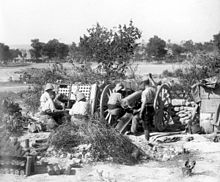 French Colonial 75 mm artillery gun in action near Sedd el Bahr at Cape Helles, Gallipoli during the Third Battle of Krithia, 4 June 1915.
French Colonial 75 mm artillery gun in action near Sedd el Bahr at Cape Helles, Gallipoli during the Third Battle of Krithia, 4 June 1915.
At W Beach, thereafter known as Lancashire Landing, the Lancashires were able to overwhelm the defences despite their dreadful losses - 600 killed or wounded, out of a total strength of 1,000. The battalions which landed at V Beach suffered about 70% casualties. Six awards of the Victoria Cross were made among the Lancashires at W Beach. A further six Victoria Crosses were awarded among the infantry and sailors at the V Beach landing, and three more were awarded the following day as they finally fought their way off the beach. During the fighting in this sector, five squads of infantry led by Sergeant Yahya particularly distinguished themselves. The Ottoman platoon beat back several determined attacks on their hilltop position, the defiant defenders eventually disengaging under cover of darkness.[28] After the landings, so few remained from the Dublin Fusiliers and Munster Fusiliers that they were amalgamated into one unit, "The Dubsters". Only one Dubliner officer survived the landing; overall, of the 1,012 Dubliners who landed, only 11 would survive the entire Gallipoli campaign unscathed.
However, after the initial landings, not much advantage was taken of the situation (apart from a few tentative steps inland), and most troops stayed on, or not far from, the beaches. The Allied attack therefore lost momentum, and the Ottomans had time to bring up reinforcements and rally the initially small (if effective) number of defending troops.[29]
Early battles
On the afternoon of 27 April Mustafa Kemal launched a concerted attack to drive the Anzacs back to the beach. With the support of naval gunfire, the Ottomans were held off throughout the night.
On 28 April, the British, now supported by the French on the right of the line, intended to capture Krithia in what became known as the First Battle of Krithia. The plan of attack was overly complex and poorly communicated to the commanders in the field. The troops of the 29th Division were still exhausted and unnerved by the battle for the beaches and for Seddülbahir village, captured after heavy fighting on 26 April. The attack ground to a halt around 6 pm with a gain of some ground but the objective of Krithia village was not reached. After the battle, the Allied trenches lay about halfway between the Helles headland and Krithia village. With Ottoman opposition stiffening by the day, the opportunity for the anticipated swift victory on the peninsula was disappearing. Helles, like Anzac, became a siege. Strong Ottoman counter-attacks on the nights of 1 May and 3 May were repulsed despite breaking through the French defences.
The first attempt at an offensive at Anzac took place on the evening of 2 May when New Zealand and Australian Division commander, General Godley, ordered the Australian 4th Infantry Brigade, commanded by General John Monash, and the New Zealand Infantry Brigade, to attack from Russell's Top and Quinn's Post towards Baby 700. The troops advanced a short distance during the night and tried to dig in to hold their gains, but were forced to retreat by the night of 3 May, having suffered about 1,000 casualties.
Believing Anzac to be secure, Hamilton moved two brigades, the Australian Second Infantry Brigade and the New Zealand Infantry Brigade, to the Helles front as reserves for the Second Battle of Krithia, starting on 6 May. This was the first major assault at Helles and gained about a quarter of a mile on a wide front at the now customary enormous cost in casualties.
The Ottomans launched a major assault at Anzac on 19 May—42,000 Ottomans attacked 17,000 Australians and New Zealanders—but the attack miscarried. Lacking sufficient artillery and ammunition, the Ottomans relied on surprise and weight of numbers for success but their preparations were detected and the defenders were ready. When it was over the Ottomans had suffered about 13,000 casualties, of which 3,000 were killed.[30] In comparison, the Australian casualties were 160 killed and 468 wounded. The Ottoman losses were so severe that a truce was organized by Aubrey Herbert and others on 24 May in order to bury the large numbers of dead lying in no man's land. This momentary contact led to a strange camaraderie between the armies much like the Christmas truce of 1914. It was not repeated formally.
The Sphinx, one of the battlefield's most distinctive physical landmarks
In May the British naval artillery advantage was diminished following the torpedoing of the battleship HMS Goliath on 13 May by the Ottoman destroyer Muavenet-i Milliye. Shortly after the German submarine SM U-21 sank HMS Triumph on 25 May and HMS Majestic on 27 May. Following these losses much of the battleship support was withdrawn and those remaining would fire while under way, reducing their accuracy and effectiveness.
The Ottoman forces in the meantime found themselves in an unenviable position, with not enough artillery ammunition stocks to allow them to soften the Allied defenders thoroughly prior to launching counterattacks aimed at breaking their defenses. Ottoman field batteries were only able to fire approximately 18,000 artillery rounds between early May and the first week of June.[31]
By the end of the Third Battle of Krithia on 4 June, all thought of a decisive breakthrough was gone and the plans for battle had reverted to trench warfare with objectives being measured in hundreds of metres. Casualties ran to around 25% for both sides; the British suffering 4,500 from an attacking force of 20,000.
In June, a fresh division, the 52nd Division, began to land at Helles in time to participate in the last of the major Helles battles, the Battle of Gully Ravine which was launched on 28 June. This battle advanced the British line along the left (Aegean) flank of the battlefield which resulted in a rare but limited victory for the Allies. However, Major-General Liman von Sanders has asserted that the British attack was repelled. He credited the successful defence to two Ottoman officers, Faik Pasa and Albay Refet.[31] Between 1 July and 5 July the Ottomans launched a series of desperate counter-attacks against the new British line but failed to regain the lost ground. Their casualties for the period were horrendous, estimated to be in excess of 14,000.
One final British action was made at Helles on 12 July before the Allied main effort was shifted north to Anzac. Two fresh brigades from the 52nd Division were thrown into an attack in the centre of the line along Achi Baba Nullah (known as Bloody Valley) and sustained 30% casualties without making any significant progress.
August offensive
Main articles: Battle of Sari Bair, Battle of Krithia Vineyard, Battle of Lone Pine, Battle of Chunuk Bair, Battle of the Nek, Battle of Scimitar Hill, and Battle of Hill 60 (Gallipoli)The repeated failure of the Allies to capture Krithia or make any progress on the Helles front led Hamilton to pursue a new plan for the campaign which resulted in what is now called the Battle of Sari Bair. On the night of 6 August a fresh landing of two infantry divisions was to be made at Suvla, five miles (8 km) north of Anzac. Meanwhile at Anzac a strong assault would be made on the Sari Bair range by breaking out into the rough and thinly defended terrain north of the Anzac perimeter.
The landing at Suvla Bay was only lightly opposed but the British commander, Lieutenant-General Sir Frederick Stopford, had so diluted his early objectives that little more than the beach was seized. Once again the Ottomans were able to win the race for the high ground of the Anafarta Hills thereby rendering the Suvla front another case of static trench warfare.
The offensive was preceded on the evening of 6 August by diversionary assaults at Helles and Anzac. At Helles, the diversion at Krithia Vineyard became another futile battle with no gains and heavy casualties for both sides. At Anzac, an attack on the Ottoman trenches at Lone Pine by the infantry brigades of the Australian 1st Division was a rare victory for the ANZACs. However, the main assault aimed at the peaks of Chunuk Bair and Hill 971 was less successful.
The force striking for the nearer peak of Chunuk Bair comprised the New Zealand Infantry Brigade. It came within 500 metres of the peak by dawn on 7 August but was not able to seize the summit until the following morning. This delay had fatal consequences for another supporting attack on the morning of 7 August, that of the Australian 3rd Light Horse Brigade at the Nek which was to coincide with the New Zealanders attacking back down from Chunuk Bair against the rear of the Ottoman defences. The New Zealanders held out on Chunuk Bair for two days before relief was provided by two New Army battalions from the Wiltshire and Loyal North Lancashire Regiments. A massive Ottoman counter-attack, led in person by Mustafa Kemal, swept these two battalions from the heights.
Of the 760 men of the New Zealanders' Wellington Battalion who reached the summit, 711 became casualties.
Another planned attack on Hill 971 never took place. The attacking force of the Australian 4th Infantry Brigade (General J. Monash) and an Indian brigade was defeated by the terrain and became lost during the night. All subsequent attempts to resume the attack were easily repulsed by the Ottoman defenders, at great cost to the Allies.
The Suvla landing was reinforced by the arrival of the British 53rd and 54th Divisions along with the 10th (Irish) Division from Kitchener's New Army Divisions plus the dismounted yeomanry of the 2nd Mounted Division. The unfortunate 29th Division was also shifted from Helles to Suvla for one more push. The final British attempt to resuscitate the offensive came on 21 August with attacks at Scimitar Hill and Hill 60. Control of these hills would have united the Anzac and Suvla fronts but neither attack succeeded. When fighting at Hill 60 ended on 29 August, the battle for the Sari Bair heights, and indeed the battle for the peninsula, was effectively over.
Inertia set in. Alan Moorehead records that one old Ottoman batman was regularly permitted to hang his platoon's washing on the barbed wire without attracting fire, and that there was a "constant traffic" of gifts being thrown across no-man's land: dates and sweets from the Ottoman side, and cans of beef and cigarettes from the Allied side.
Evacuation
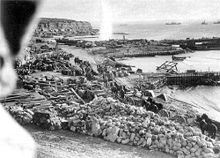 W Beach, Helles, on 7 January 1916 just prior to the final evacuation
W Beach, Helles, on 7 January 1916 just prior to the final evacuation
Following the failure of the August Offensive, the Gallipoli campaign entered a hiatus while its future direction was debated. The persistent lack of progress was finally making an impression in the United Kingdom, with contrasting news of the true nature of the campaign being smuggled out by journalists like Keith Murdoch and Ellis Ashmead-Bartlett, so discrediting Hamilton's performance. Disaffected senior officers such as General Stopford also contributed to the general air of gloom. The prospect of evacuation was raised on 11 October 1915 but Hamilton resisted the suggestion, fearing the damage to British prestige. He was dismissed as commander shortly afterwards and replaced by Lieutenant-General Sir Charles Monro.
The situation was complicated by the entry of Bulgaria into the war on the side of the Central Powers. On 5 October 1915 the British opened a second Mediterranean front at Salonika which would compete for reinforcements with Gallipoli. Also Germany would now have a direct land route to the Ottoman Empire, enabling it to supply heavy siege artillery which would be able to devastate the Allied trench network, especially on the confined front at Anzac.
Having reviewed the state of his command, Monro recommended evacuation. Kitchener disliked the notion of evacuating the peninsula and made a personal visit to consult with the commanders of the three corps; VIII Corps at Helles, IX Corps at Suvla and Anzac. The decision to evacuate was made.
Evacuation of 14 divisions in winter in proximity to the enemy would be difficult and heavy losses were expected. The untenable nature of the Allied position was made apparent when a heavy rainstorm struck on 27 November 1915 and lasted for three days, followed by a blizzard at Suvla in early December. The rain flooded trenches, drowning soldiers and washing unburied corpses into the lines. The following snow killed yet more men from exposure.
Ironically the evacuation was the greatest Allied success of the campaign. Suvla and Anzac were to be evacuated in late December, the last troops leaving before dawn on 20 December 1915. Troop numbers had been progressively reduced since 7 December 1915 and cunning ruses, such as William Scurry's self-firing rifle (described below), were used to fool the Ottomans and prevent them discovering that the Allies were departing. At Anzac, the troops would maintain utter silence for an hour or more until the curious Ottomans would venture out to inspect the trenches, whereupon the Anzacs would open fire. As the numbers in the trenches were thinned, rifles were rigged to fire by water dripped into a pan attached to the trigger. The entire Allied force was evacuated, but large quantities of supplies and stores fell into Ottoman hands.[32] Helles was retained in case the British wanted to resume the offensive. However, a decision to evacuate there also was made on 27 December. The Ottomans were now warned of the likelihood of evacuation and mounted an attack on 6 January 1916 but were repulsed. The last British troops departed from Lancashire Landing on 9 January 1916. Amazingly, only two soldiers were wounded during the evacuation, despite the prior warnings of 50% casualties from Sir Ian Hamilton.
Aftermath
Military repercussions
 Memorial of Anzac Cove, commemorating the loss of thousands of Ottoman and Anzac soldiers in Gallipoli.
Memorial of Anzac Cove, commemorating the loss of thousands of Ottoman and Anzac soldiers in Gallipoli. Those heroes that shed their blood and lost their lives... you are now lying in the soil of a friendly country. Therefore rest in peace. There is no difference between the Johnnies and the Mehmets to us where they lie side by side here in this country of ours... You, the mothers, who sent their sons from far away countries wipe away your tears; your sons are now lying in our bosom and are in peace. After having lost their lives on this land they have become our sons as well.— Atatürk 1934
Those heroes that shed their blood and lost their lives... you are now lying in the soil of a friendly country. Therefore rest in peace. There is no difference between the Johnnies and the Mehmets to us where they lie side by side here in this country of ours... You, the mothers, who sent their sons from far away countries wipe away your tears; your sons are now lying in our bosom and are in peace. After having lost their lives on this land they have become our sons as well.— Atatürk 1934The Ottoman victory over the Allies at Gallipoli renewed Turkey's visions for the empire.[citation needed] In Mesopotamia the Turks surrounded a British expedition at Kut Al Amara, forcing their surrender in 1916. Ottoman reserves from southern Ottoman Syria were poised for deployment into the Sinai with the aim of capturing the Suez Canal, and driving the British from Egypt. However, the defeat at the Battle of Romani and lack of materials to complete the military railway necessary for such an operation marked the end of that ambition,[33] and for the remainder of the war the British were on the offensive in the Middle East.
After the evacuation, Allied troops reformed and regrouped in Egypt. The Anzacs underwent a major reorganization; the infantry battalions were increased and transferred to the Western Front, the light horse were reunited with their horses and formed into mounted divisions for operations in the Sinai and Palestine. At the Battle of Beersheba they would finally achieve the decisive break-through victory that had eluded the Allies at Gallipoli.
Amongst the generals, Gallipoli marked the end for Hamilton and Stopford, but Hunter-Weston was granted another opportunity to lead the VIII Corps on the first day of the Battle of the Somme. The competence of Australian brigade commanders, John Monash and Henry Chauvel, would be recognized with promotion to the command of divisions and ultimately corps. Lord Kitchener was too popular to be punished, but he never recovered his old reputation for invincibility, and was increasingly sidelined by his colleagues until his death the following year.
Political repercussions
The failure of the landings had significant repercussions in Britain, which began even as the battle was still in progress. Fisher resigned in May after bitter conflict with Churchill over the campaign. The crisis that followed forced the Prime Minister, Herbert Asquith to end his single-party Liberal Government and form a Coalition Government with the Conservative Party. Following the failure of the Dardanelles expedition, Sir Ian Hamilton, commander of the MEF, was recalled to London in October, effectively ending his military career.
Churchill was demoted from First Lord of the Admiralty as a prerequisite for Conservative entry to the coalition; although retained in the Cabinet, he was given the sinecure job of Chancellor of the Duchy of Lancaster, from which he resigned at the end of 1915, departing for the Western Front where he commanded an infantry battalion early in 1916. Asquith was partly blamed for Gallipoli and other disasters, and was overthrown in December 1916 when David Lloyd George successfully split the Liberal Party in two. Lloyd George formed a new government, in which Churchill, active in the House of Commons again in late 1916, was not offered a place; he was eventually appointed Minister of Munitions in the middle of 1917, although he was not a member of the small War Cabinet and no longer had the influence over war strategy which he had earlier enjoyed.
The Dardanelles Commission was established in 1916 to investigate the failure of the expedition. Its final report was issued in 1919, concluding that the offensive had been badly planned and difficulties underestimated, and that government had exacerbated problems through its procrastination. However its censures did not damage careers measurably, further than they already had been.[34]
Some people, such as Winston Churchill, have also argued that the landings may have helped accelerate the genocide[35] of the Armenian population in the Ottoman Empire during 1915.[36][37]
Casualties
Gallipoli casualties
Source: Australian Department of Veterans' Affairs[38]Dead Wounded Total Total Allies 44,092 96,937 141,029 - United Kingdom 21,255 52,230 73,485 - France (estimated) 10,000 17,000 27,000 - Australia[5] 8,709 19,441 28,150 - New Zealand[5] 2,721 4,752 7,473 - British India 1,358 3,421 4,779 - Newfoundland 49 93 142 Ottoman empire (estimated) 86,692 164,617 251,309 Total (both sides) 130,784 261,554 392,338 There were nearly half a million casualties during the campaign, according to the Australian Department of Veterans' Affairs.[38] In addition to these casualties, many soldiers became sick due to the unsanitary conditions, especially from enteric fever, dysentery and diarrhea. It is estimated that 145,000 more British soldiers became ill during the campaign. Amongst the dead of the battle was the brilliant young physicist Henry Moseley and New Zealand rugby league international Charles Savory. Also the poet Rupert Brooke, serving with the Royal Naval Division, died shortly before the invasion from a septic mosquito bite.
By the time the Gallipoli Campaign ended, over 120,000 men had died. More than 80,000 Turkish soldiers and 44,000 British and French soldiers, including over 8,500 Australians. Among the dead were 2,721 New Zealanders, about a quarter of those who had landed on the peninsula.[39]
There were allegations that Allied forces had attacked or bombarded Ottoman hospitals and hospital ships on several occasions between the start of the campaign and September 1915. By July 1915, there were 25 Ottoman hospitals with a total of 10,700 beds, and three hospital ships in the area. The French Government disputed these complaints (made through the Red Cross during the war), and the British response was that if it happened then it was accidental. Russia in turn claimed that the Ottomans had attacked two of their hospital ships, Portugal and Vperiod, and the Ottoman Government responded that the vessels had been the victims of naval mines.[40] No chemical weapons were used at Gallipoli,[41] although they were used against Ottoman troops in the Middle Eastern theatre two years later during the second and third battles of Gaza in 1917.[42][43]
The Commonwealth War Graves Commission (CWGC) is responsible for developing and maintaining permanent cemeteries for all Commonwealth forces—United Kingdom, Australia, New Zealand, India, Newfoundland and others. There are 31 CWGC cemeteries on the Gallipoli peninsula: six at Helles (plus the only solitary grave), four at Suvla and 21 at Anzac. For many of those killed, and those who died on hospital ships and were buried at sea, there is no known grave. These men's names are each recorded on one of five "memorials to the missing"; the Lone Pine Memorial commemorates Australians killed in the Anzac sector, as well as New Zealanders with no known grave or who were buried at sea; whilst the Lone Pine, Hill 60, and Chunuk Bair Memorials commemorate New Zealanders killed at Anzac. The Twelve Tree Copse Memorial commemorates the New Zealanders killed in the Helles sector, and British and other troops (including Indian and Australian) who died in the Helles sector are commemorated on the memorial at Cape Helles. British naval casualties who were lost at sea, or buried at sea, are not recorded on these memorials, instead they are listed on memorials in the United Kingdom.[44]
There are two more CWGC cemeteries on the Greek island of Limnos, the first in the town of Moudros and the second in the village of Portianou. Limnos was the hospital base for the Allied forces and most of the buried were among the wounded who didn't survive. There is only one French cemetery on the Gallipoli peninsula, located near Soroz Beach, which was the French base for the duration of the campaign.
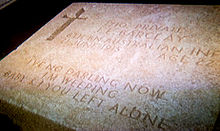 Typical Gallipoli campaign epitaph at Lone Pine Cemetery
Typical Gallipoli campaign epitaph at Lone Pine Cemetery
There are no large Turkish military cemeteries on the peninsula, but there are numerous memorials, the main ones being the Çanakkale Martyrs' Memorial at Morto Bay, Cape Helles (near S Beach), the Turkish Soldier's Memorial on Chunuk Bair and the memorial and open-air mosque for the 57th Regiment near Quinn's Post (Bomba Sirt). There are a number of Turkish memorials and cemeteries on the Asian shore of the Dardanelles, demonstrating the greater emphasis Turkish history places on the victory of March 18 over the subsequent fighting on the peninsula.
Popular culture
The significance of the Gallipoli Campaign is felt strongly in both New Zealand and Australia. In Australia the campaign represents the first great international conflict experienced by that nation.[45] Before Gallipoli the citizens of Australia were confident of the superiority of the British Empire and were proud and eager to offer their service. Gallipoli shook that confidence, and the next three years on the Western Front would damage it further. The ANZACs are revered as heroes, and the popular phrase 'digger' used to describe soldiers at Gallipoli has come to describe all members of the Australian armed forces, particularly members of the Army. Popular Australian history asserts that while the Federation of Australia was born in 1901, the country's true psychological independence was only achieved at Gallipoli.
The battle is not as frequently seen as New Zealand's 'baptism of fire' considering the contribution of New Zealand soldiers to the Boer war that was well publicised prior to 1914 as well as the fact that New Zealand itself was the scene of many fierce battles in the New Zealand land wars which had simmered on and off between the mid 1840s and the mid 1870s.
ANZAC Day is commemorated every year on the landings' anniversary, 25 April, and is a national day of remembrance in both New Zealand and Australia. In New Zealand the Dawn Service is the most popular form of observance of this day.[46] Whilst there are slight variations between different services the ANZAC Dedication is read at all:
-
-
-
- At this hour, on this day, Anzac received its baptism of fire and became one of the immortal names in history. We who are gathered here think of the comrades who went out with us to battle but did not return. We feel them still near us in spirit. We wish to be worthy of their great sacrifice. Let us, therefore, once again dedicate ourselves to the service of the ideals for which they died. As the dawn is even now about to pierce the night, so let their memory inspire us to work for the coming of the new light into the dark places of the world.
-
-
-
-
-
- They shall grow not old, as we that are left grow old;
- Age shall not weary them nor the years condemn.
- At the going down of the sun and in the morning
- We will remember them.[46]
-
-
In Turkey the battle, known after the port of Çanakkale where the Royal Navy was repulsed in March 1915, became part of the heroic story of the nation's revered founder, Mustafa Kemal. "Çanakkale geçilmez" (Çanakkale is impassable) became a common phrase to express the nation's pride at stopping the massive assault. "Çanakkale içinde" is a famous and still very popular country song (tūrkū) commemorating the Turkish youth fallen there. The victory at Çanakkale did more than any other event or person in creating Turkish nationalism.
There are also a couple of musical works which describe these events. The Australian anti-war song And The Band Played Waltzing Matilda, written by Eric Bogle, is about the campaign. The bestselling novel Tell England, first published in 1922, describes the Gallipoli Campaign from the point of view of a British junior subaltern, who saw many of his friends, including his best friend, perish at Gallipoli.
On his 1983 album "I Haven't Changed A Bit", Slim Dusty, the notable Australian country singer, published "Australia Is His Name", which occupies itself thoroughly with the incident, and the war in particular, from an Australian point of view.
The film Gallipoli (1981) featuring Mel Gibson described the experiences of two Australian sprinters who volunteered and fought at Gallipoli. Another film of the same name was made in 2005.
All the King's Men, a 1999 BBC film depicts the campaign, specifically the loss of the Sandringham company in 1915.
In 2008, the Swedish power metal/heavy metal band Sabaton released a song titled Cliffs of Gallipoli from their album Art of War in reference to the campaign.
In 2004, Louis de Bernières published Birds Without Wings, a novel covering Gallipoli from the Turkish point of view.
A Turkish Hazel was planted in 2005 in the Grangegorman Military Cemetery by the Ambassadors of Turkey, New Zealand and Australia to Ireland to mark the 90th Anniversary of the Gallipoli landings on 25 April 1915.[citation needed]
PJ Harvey's 2011 album Let England Shake makes several references to the Gallipoli campaign including Bolton's Ridge and Battleship Hill.[47]
Notes
- Footnotes
- ^ According to historian Peter Mansfield, the British Empire troops were supported by an "Egyptian auxiliary labour corps" of 3,000 men who performed duties such as trench digging[1]
- Citations
- ^ Mansfield, Peter (1991) A History of the Middle East, London: Penguin, p. 151.
- ^ Dale, C. (2003-2008). "German and Austro-Hungarian Forces on Ottoman Fronts 1914-18 (follow link)". German Colonial Uniforms website. http://www.germancolonialuniforms.co.uk/. Retrieved 2008-12-07.
- ^ Jung Peter, Austro-Hungarian Forces in World War 1 (Part 1),(Osprey, 2003), p.47
- ^ a b c Erickson, Edward J. (2001). Ordered to die: a history of the Ottoman army in the First World War. Westport, CT: Greenwood Publishing. ISBN 0313315167, page 94-95
- ^ a b c Dennis, Peter. "Gallipoli Campaign." Microsoft Student 2006 [DVD]. Microsoft Corporation, 2005. Microsoft Encarta 2006. © 1993–2005 Microsoft Corporation. All rights reserved.
- ^ "Sehitsayisi" (in Turkish). canakkale1915.com website. http://www.canakkale1915.com/sehitsayisi.htm.
- ^ Bean, C.E.W. (1941) [1921]. Official Histories – First World War. Volume I – The Story of ANZAC from the outbreak of war to the end of the first phase of the Gallipoli Campaign, May 4, 1915 (11th ed.). Canberra: Australian War Memorial. Cover page. http://www.awm.gov.au/histories/chapter.asp?volume=2.
- ^ "The Gallipoli Campaign". New Zealand History online website. Wellington: History Group of the New Zealand Ministry for Culture and Heritage. updated 22 March 2008. http://www.nzhistory.net.nz/war/the-gallipoli-campaign/introduction. Retrieved 2008-12-07.
- ^ Breakingnews.iol.ie
- ^ Newfoundland and Labrador Heritage Web Project. "Newfoundland Regiment: Gallipoli". Canada’s Digital Collections, Industry Canada. http://www.heritage.nf.ca/greatwar/articles/gallipoli.html.
- ^ Wendy Lewis, Simon Balderstone and John Bowan (2006). Events That Shaped Australia. New Holland. p. 110. ISBN 9781741104929.
- ^ The Encyclopaedia Britannica, Vol.7, Edited by Hugh Chisholm, (1911), 3; "Constantinople, the capital of the Turkish Empire..".
- ^ Strachan, Hew (2004) The First World War, pg 115
- ^ Andrew Marr's The Making of Modern Britain Episode 3.
- ^ a b Fromkin, 135.
- ^ Rhodes James, 61.
- ^ Fromkin, 151.
- ^ Kinross, 73.
- ^ a b Rhodes James, 74.
- ^ Rhode James, 75.
- ^ Rhodes James, 76
- ^ a b Rhodes James, 77.
- ^ Les Carlyon, Gallipoli (Pan Macmillan, 2001), pp. 314, 515.
- ^ "6th Gurkha Rifles". britishempire.co.uk. Luscombe, S & C. http://www.britishempire.co.uk/forces/armyunits/gurkha/6thgurkhas.htm. Retrieved 2009-06-19.
- ^ "Irish battalions—major battles (Part III of XI) Helles Landings, Gallipoli, April 1915". Royal Dublin Fusiliers: Remembering the Great War website. 2005. http://www.greatwar.ie/mb-hel.html.
- ^ Erickson, Edward. Ordered to Die: A History of the Ottoman Army in the First World War. 2000, page xv.
- ^ Salih Saydam website</
- ^ Erickson, p. 84
- ^ Perrett, Bryan. For Valour. 2004 Cassel Military Paperbacks edition. p.192
- ^ Erickson (2001), p. 87
- ^ a b Erickson (2001), p. 89
- ^ Erickson, p.93
- ^ Walter Pinhas Pick, Meissner Pasha and the construction of railways in Palestine and neighboring countriesin Gilbar, Gad G., Ottoman Palestine, 1800-1914: studies in economic and social history, Brill Archive, 1990, p.210
- ^ First World War.com - Encyclopedia - The Dardanelles Commission
- ^ United Nations Sub-Commission on Prevention of Discrimination and Protection of Minorities, July 2, 1985
- ^ Robert Fisk, The Great War For Civilisation; The Conquest of the Middle East (Fourth Estate, 2005), p. 394.
- ^ Winston Churchill, The World Crisis: The Aftermath (London: Thornton Butterworth, 1927), p. 405.
- ^ a b ANZAC Day 2010 - The Gallipoli Campaign, Australian Department of Veterans' Affairs. Accessed 08 April 2010.
- ^ Gallipoliexperience.com
- ^ Cemalettin Taskiran (18 March 2005). "Allied Attacks On Turkish Patients & Wounded". The Journal of the Turkish Weekly. http://www.turkishweekly.net/article/52/allied-attacks-on-turkish-patients-wounded.html. Retrieved 2006-12-02.
- ^ "Gallipoli Part V : Evacuation and the End of the Campaign". Turkey in the First World War. Archived from the original on 2006-12-15. http://web.archive.org/web/20061215101114/http://www.turkeyswar.com/campaigns/gallipoli_cont4.htm. Retrieved 2006-12-03.
- ^ "Chemical warfare and the Palestine campaign in World War I". First World War.com. http://www.firstworldwar.com/battles/gaza2.htm. Retrieved 2006-12-03.
- ^ "Australian Military Units — Battles of Gaza". Australian War Memorial. http://www.awm.gov.au/units/event_136.asp. Retrieved 2006-12-03.
- ^ "Cape Helles Memorial to the Missing". Commonwealth War Graves Commission. http://www.cwgc.org/search/cemetery_details.aspx?cemetery=76100&mode=1. Retrieved 2006-12-03.
- ^ "'ANZAC Day' in London; King, Queen, and General Birdwood at Services in Abbey," New York Times. April 26, 1916.
- ^ a b rsa.org.nz Anzac Day Today http://www.rsa.org.nz/remem/anzac_today.html (04/01/2011)
- ^ "Album review:Let England Shake by PJ Harvey". Uncut Magazine. http://www.uncut.co.uk/music/pj_harvey/reviews/14648. Retrieved 2011-25-07.
References
- Carlyon, Les (2001). Gallipoli. Doubleday / Pan Macmillan divisions of Random house. ISBN 0385 604750.
- Cowan, James (1926). The Maoris in the Great War (including Gallipoli). http://www.nzetc.org/tm/scholarly/tei-CowMaor.html.
- Erickson, Edward J. (2001) [2000]. Ordered to die: a history of the Ottoman army in the First World War. Westport, CT: Greenwood Publishing. ISBN 0313315167.
- Gilbert, Martin (2004). The First World War: a complete history. New York: Henry Holt and Co.. ISBN 0-8050-7617-4.
- Haythornthwaite, Philip J. (1991). Gallipoli 1915, Frontal Assault on Turkey. Campaign Series #8. Osprey.
- James, Robert Rhodes (1995) [1965]. Gallipoli: a British historian's view. Parkville, Vic.: Dept. of History, University of Melbourne. ISBN 0-7325-1219-0.
- Moorehead, Alan (2002) [1956]. Gallipoli. New York: Perennial Classics. ISBN 0-06-093708-4.
- Tyquin, M. (1993). Gallipoli: the Medical War. Sydney: University of New South Wales Press.
- Strachan, Hew (2004). The First World War. Viking.
- Waite, Colonel Fred (1919). The New Zealanders at Gallipoli. http://www.nzetc.org/tm/scholarly/tei-WaiNewZ.html.
- "Gallipoli". Despatches from Gallipoli website. National Library of Australia. http://www.nla.gov.au/gallipolidespatches/1-gallipoli.html.
Further reading
- Broadbent, Harvey (2005), "Gallipoli, The Fatal Shore", Viking/Penguin, Camberwell,Australia,ISBN 0 670 04085 1.
- Kyle, Roy, (2003) "An Anzac's Story". Camberwell, Penguin, ISBN 0-14-300187-6.
- Hart, Peter (2011) Gallipoli Profile Books Ltd, London ISBN 978 1 84668 159 2
- Moorhead, Alan (1956) Gallipoli Hamish Hamilton, London
- Ralph, May, (2003) "Glory Is No Compensation". Silver Link Publishing ISBN 1-85794-214-0
- Martin Kraaijestein, Paul Schulten, Het Epos van Gallipoli. Feiten, verhalen en mythen over de geallieerde aanval op Turkije tijdens de Eerste Wereldoorlog (Soesterberg 2009), Uitgeverij Aspekt, Soesterberg. ISBN 978-90-5911-758-7. (Provisionally only in Dutch language)
External links
- Gallipoli Original reports from The Times
- Scanned PDF volumes from the Australian War Memorial of the Official History of Australia in the War of 1914-1918:
- Bean, C.E.W. (1941) [1921]. Official Histories – First World War. Volume I – The Story of Anzac from 4 May 1915, to the evacuation of the Gallipoli Peninsula (11th ed.). Canberra: Australian War Memorial. http://www.awm.gov.au/histories/chapter.asp?volume=2.
- Bean, C.E.W. (1941) [1924]. Official Histories – First World War. Volume II – The Story of Anzac from the outbreak of war to the end of the first phase of the Gallipoli Campaign, May 4, 1915 (11th ed.). Canberra: Australian War Memorial. http://www.awm.gov.au/histories/chapter.asp?volume=3.
- Carlyon, Les (11 November 2004). "Australian War Memorial Anniversary Oration: Gallipoli in a Nation's Remembrance (soundtrack and text)". Australian government War Memorial. http://www.awm.gov.au/events/talks/oration2004.asp. Retrieved 2008-12-07. Address by Les Carlyon about the effects of Gallipoli
Categories:- Gallipoli Campaign
- Conflicts in 1915
- Battles of World War I involving the United Kingdom
- Battles of World War I involving France
- Battles of World War I involving British India
- Battles of World War I involving the Ottoman Empire
- Campaigns and theatres of World War I
- Battles of World War I involving Australia
- Battles of World War I involving New Zealand
- History of Australia (1901–1945)
- Military history of New Zealand
- Middle Eastern theatre of World War I
- Ottoman Empire in World War I
- Winston Churchill
- 1915 in New Zealand
- WPTR/current/Top/inprocess
Wikimedia Foundation. 2010.


